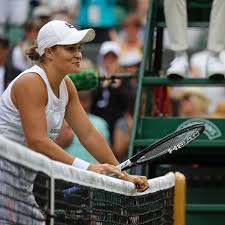As you drive to the city from Melbourne’s Tullamarine Airport, the giant billboards on the overpasses leave little doubt about who is the star attraction of this year’s Australian Open.
If you have come from overseas and are keen to taste the local “delicacy”, you might find the contents of supermarket shelves confusing: Vegemite has been rebranded as Bartymite.
You can be certain TV coverage of Ashleigh Barty’s first Australian Open match will leave no angle uncovered.
Cameras will follow her every step from the locker room to the practice court as analysts engage in earnest speculation about her form, health and hemline.
Others in the media will fret about how Barty will handle the crushing pressure of carrying the world number one ranking into her home grand slam tournament while simultaneously adding to that burden with our every word, image and meme.
Meanwhile, those such as Pat Cash, Pat Rafter, Lleyton Hewitt, Jelena Dokic and, from a corner in the women’s locker room, Samantha Stosur, who have been bent and sometimes broken by the weight of historical expectation, will observe this Barty — ummm, has anyone used Party yet? — with a knowing sigh.
Will Ash be the first local champion crowned since the 70s?
The captaincy of the national cricket teams, the honour of Olympic representation and prominent roles in other international and domestic outfits come with high levels of scrutiny and public accountability.
But is there a more crushing burden than to be the great Australian hope at our national tennis championship, a time when reality is so often exceeded by sheer desperation to see the first local champion crowned since the seventies?
In my tennis-reporting lifetime, the nadir in ratings-driven flag-waving hysteria was the build-up to Pat Rafter’s centre-court match against Andre Agassi at the 1995 Australian Open in which, according to the TV myth-making, the late-blooming Australian would challenge an all-time great near the peak of his powers.
Instead, Agassi’s relentless straight-sets destruction of Rafter merely exposed the frenzied build-up as a by-product of the desperation for somebody — anybody — to break the long Australian singles drought.
In subsequent years when there has been a genuine Australian hope (most significantly Hewitt’s appearance in the 2005 final) or confected interest around Australians who were clearly overmatched, the hyperbole has not diminished.
This panders to the millions of two-weeks-a-year tennis fans who have little more idea about where the Australians stand in the rankings than once-a-year punters do about the form of the Melbourne Cup runners, let alone the capabilities of their “foreign” opponents.
Australians were once not alone in allowing patriotic fervour to double-bagel common sporting sense during a major tennis tournament due to a lack of recent success.
Wimbledon had Henmania with its hordes of sunburnt fans bedecked in Union Jack apparel camped on Henman’s Hill, while home viewers fretted over every groundstroke.
This was far a more hysterical and yet also more amusing version of the universal expectation placed on our Great Australian Open Hopes.
Like the subject of the national adoration, the plucky Tim Henman had a somewhat ironic and self-effacing veneer reflected in his hilariously inappropriate nickname “Tiger Tim”.
Henman’s heroics mostly came before such great British triumphs as the 2005 Ashes series, the 2012 Olympics and, yes, the Wimbledon victory of Andy Murray — accomplishments that have seen once endearingly self-loathing English sports commentary take on a more jingoistic tone.
A tone not unlike what has accompanied Australian sport, where chest-beating about international achievement — or, at Melbourne Park, the merest hint of it — has often been a substitute for a lack of genuine self-esteem. Oi oi oi!
Barty’s ‘cloak of normality’ will shelter her from worst of the hype
For all that, the intense spotlight under which Barty will perform at Melbourne Park this year is exaggerated but at least not unexpected.
Barty will have been well-prepared for the hysteria surrounding her return to Australia as the world number one and reigning French Open champion.
As the new naming rights holder of the popular yeast-based sandwich spread, among other lucrative endorsements, she is even (quite deservedly) making a personal profit from it.
Beyond the words of wisdom Barty has no doubt received from the wise heads in her entourage, the great hope is that the 23-year-old will be shielded from public and media expectations by her “cloak of normality”.
Barty has cited a number of factors that contributed to her decision to walk away from tennis as a promising teenager, including her mental well-being, her craving for a “normal life” and her loss of appetite for the travel, pressures and other demands of the tennis circuit.
Yet it now seems Barty was intuitive about her fate, knowing time away for the game would provide her with both perspective and the maturity required to cope with the success her incredible talent would always bring.
Rather than flame out on the tour like so many teen phenoms who went straight from cradle to centre court, Barty stepped away during the most vulnerable and potentially damaging time in her career — a period during which she would have been under intense pressure from home audiences that her still callow game did not justify.
Will this steel Barty for the even greater expectations we will place on her in the coming days, and hopefully weeks, at Melbourne Park?
The Queenslander at least gives the impression that, unlike some others who have carried the title of Great Aussie Hope, she has the necessary combination of talent, preparation and maturity to play unencumbered by our hopes, it not her own.
If so, whatever she delivers will be the best we could have reasonably and unreasonably have expected.

